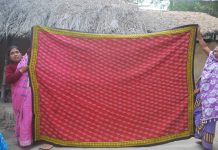Women in indigenous, ethnic communities in Bangladesh continue to use the traditional back strap loom known as bain tant for weaving their own clothes.. They also weave designed cloth for ceremonial and ritual use.
In Chittagong Hill Tracts, in at least eleven communities women weave sarongs and scarves whose designs and names are particular to each community. The sarongs vary in length, from the ankle length pinon worn by Chakma women to Mro women’s wanklai, barely covering 9-11 inches below the waist. Traditionally the pinon was black with fine lines of dark blue and red bands, at the top and bottom. On one side of the pinon an intricate border known as sabugi or chabugi is woven in different colours. Lushai women’s sarong is woven with multi-colored, geometric designs on white. The Taungchengya sarong is woven with red, white and yellow stripes on a black warp. Chak women sarongs have long, horizontal stripes. (Dewan, 2002, p 9-12)
Young Chakma women are expected to weave a design sampler known as alam, with motifs depicting flowers, birds, animals, tiger’s paws, snail’s tail, snake’s backbone. (Chakma, 2002, p. 4) Three old alams are on display at the Tribal Museum in Rangamati. The Tangon is woven as a ritual gift for the Buddhist temple. (Chakma, 2009)
The Garo women of Mymensing call their sarongs dokbandha, while Manipuri women in Moulvi bazar, Habiganj, Sylhet and Sunamganj weave a phanek (sarong), a phurit (blouse), and a phidu or inaphi (scarf). Their dance dress is a stylized skirt and a pointed cap with a veil.
Ethnic women used to gin the cotton and roll it by hand onto a pech, before spinning it into yarn on a charka or spinning wheel. Cotton is no longer cultivated in Bangladesh, instead yarn is imported and sold in local markets. The weaver sits on the floor with legs stretched in front with the beam tied around her waist.
In addition to their traditional clothes women today are also weaving blankets, shawls and bedspreads for both the urban and international market.
Further reading
Athena Gallery, 3 Generation, Athena Gallery of Fine Arts Catalogue, Dhaka
Chakma M., and Zaman, N., Tradition of Backstrap Weaving in Bangladesh, Dhaka, 2009
Dewan, A., “Woven Textiles as Art: Examination of the Revival of Weaving in the Chittagong Hill Tracts”, Master’s Thesis at Concordia University, Montreal, 2002
Haque, E., “Textiles of Ethnic Communities of Bangladesh,“ in Textile Traditions of Bangladesh, Dhaka, National Crafts Council of Bangladesh, 2006.





